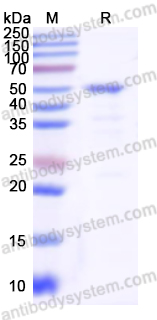Catalog No.
YHD27501
Expression system
E. coli
Species
Homo sapiens (Human)
Protein length
Asn2-Ala439
Predicted molecular weight
51.38 kDa
Nature
Recombinant
Endotoxin level
Please contact with the lab for this information.
Purity
>90% as determined by SDS-PAGE.
Accession
P17980
Applications
ELISA, Immunogen, SDS-PAGE, WB, Bioactivity testing in progress
Form
Lyophilized
Storage buffer
Lyophilized from a solution in PBS pH 7.4, 0.02% NLS, 1mM EDTA, 4% Trehalose, 1% Mannitol.
Reconstitution
Reconstitute in sterile water for a stock solution. A copy of datasheet will be provided with the products, please refer to it for details.
Shipping
In general, proteins are provided as lyophilized powder/frozen liquid. They are shipped out with dry ice/blue ice unless customers require otherwise.
Stability and Storage
Use a manual defrost freezer and avoid repeated freeze thaw cycles. Store at 2 to 8°C for frequent use. Store at -20 to -80°C for twelve months from the date of receipt.
Alternative Names
26S proteasome AAA-ATPase subunit RPT5, Tat-binding protein 1, Proteasome 26S subunit ATPase 3, Proteasome subunit P50, 26S proteasome regulatory subunit 6A, TBP-1, PSMC3, TBP1
Rational strategies for designing next-generation oncolytic viruses based on transcriptome analysis of tumor cells infected with oncolytic herpes simplex virus-1., PMID:39850819
Nuclear factor erythroid 2-related factor 1 regulates the expression of proteasomal genes in ketotic cows and protects mammary cells against free fatty acid-induced endoplasmic reticulum stress., PMID:39343197
Procyanidin B1 Promotes PSMC3-NRF2 Ubiquitination to Induce Ferroptosis in Glioblastoma., PMID:39293861
PSMD11 loss-of-function variants correlate with a neurobehavioral phenotype, obesity, and increased interferon response., PMID:38866022
Systematic selection of suitable reference genes for quantitative real-time PCR normalization studies of gene expression in Lutjanus erythropterus., PMID:38858385
PARP7-mediated ADP-ribosylation of FRA1 promotes cancer cell growth by repressing IRF1- and IRF3-dependent apoptosis., PMID:38011562
PSMC3 proteasome subunit variants are associated with neurodevelopmental delay and type I interferon production., PMID:37256937
MicroRNAs affecting the susceptibility of melanoma cells to CD8+ T cell-mediated cytolysis., PMID:36718025
PSMC3 promotes RNAi by maintaining AGO2 stability through USP14., PMID:36528617
Hepatitis B Virus X Protein Is Stabilized by the Deubiquitinating Enzyme VCPIP1 in a Ubiquitin-Independent Manner by Recruiting the 26S Proteasome Subunit PSMC3., PMID:35695579
Identifying Potential Mitochondrial Proteome Signatures Associated with the Pathogenesis of Pulmonary Arterial Hypertension in the Rat Model., PMID:35237384
Prioritization of human well-being spectrum related GWAS-SNVs using ENCODE-based web-tools predict interplay between PSMC3, ITIH4, and SERPINC1 genes in modulating well-being., PMID:34883412
Effectiveness of bortezomib and temozolomide for eradication of recurrent human glioblastoma cells, resistant to radiation., PMID:34689859
Prognoses and genomic analyses of proteasome 26S subunit, ATPase (PSMC) family genes in clinical breast cancer., PMID:34329194
The transcriptional regulator Zfat is essential for maintenance and differentiation of the adipocytes., PMID:33522619
Restoration of circPSMC3 sensitizes gefitinib-resistant esophageal squamous cell carcinoma cells to gefitinib by regulating miR-10a-5p/PTEN axis., PMID:32997362
Proteasome subunit PSMC3 variants cause neurosensory syndrome combining deafness and cataract due to proteotoxic stress., PMID:32500975
CircPSMC3 Suppresses Migration and Invasion of Non-Small Cell Lung Cancer Cells via miR-182-5p/NME2 Axis., PMID:32386284
Circ PSMC3 inhibits prostate cancer cell proliferation by downregulating DGCR8., PMID:32196577
Functions of circular RNAs and their potential applications in gastric cancer., PMID:31922886
Landscape of ubiquitination events that occur in host skin in response to tick (Haemaphysalis longicornis) bitten., PMID:31838045
Circular circPSMC3 inhibits hepatocellular carcinoma migration and invasion by upregulating RBM5., PMID:31726810
CircPSMC3 suppresses the proliferation and metastasis of gastric cancer by acting as a competitive endogenous RNA through sponging miR-296-5p., PMID:30777076
δ-Tocotrienol feeding modulates gene expression of EIF2, mTOR, protein ubiquitination through multiple-signaling pathways in chronic hepatitis C patients., PMID:30031388
Disruption of Ssp411 causes impaired sperm head formation and male sterility in mice., PMID:29247744
GT198 (PSMC3IP) germline variants in early-onset breast cancer patients from hereditary breast and ovarian cancer families., PMID:28435519
Downregulation of SIRT7 by 5-fluorouracil induces radiosensitivity in human colorectal cancer., PMID:28435470
Caspase-related apoptosis genes in gliomas by RNA-seq and bioinformatics analysis., PMID:27469411
Screening of cellular proteins that interact with the classical swine fever virus non-structural protein 5A by yeast two-hybrid analysis., PMID:24499791
Involvement of Bag6 and the TRC pathway in proteasome assembly., PMID:23900548
Platelet-derived growth factor CC-mediated neuroprotection against HIV Tat involves TRPC-mediated inactivation of GSK 3beta., PMID:23077641
Intergenic region between TATA-box binding protein and proteasome subunit C3 genes of Medaka function as the bidirectional promoter in vitro and in vivo., PMID:23026219
A regulatory mechanism involving TBP-1/Tat-Binding Protein 1 and Akt/PKB in the control of cell proliferation., PMID:21991300
AGR2 is a novel surface antigen that promotes the dissemination of pancreatic cancer cells through regulation of cathepsins B and D., PMID:21948970
A 19S proteasomal subunit cooperates with an ERK MAPK-regulated degron to regulate accumulation of Fra-1 in tumour cells., PMID:21874050
Identification of cellular proteins interacting with equine infectious anemia virus S2 protein., PMID:20417672
The 19S ATPase S6a (S6'/TBP1) regulates the transcription initiation of class II transactivator., PMID:19853614
Roles of proteasomal 19S regulatory particles in promoter loading of thyroid hormone receptor., PMID:19555666
Rnf19a, a ubiquitin protein ligase, and Psmc3, a component of the 26S proteasome, tether to the acrosome membranes and the head-tail coupling apparatus during rat spermatid development., PMID:19517565
Tat-binding protein-1 (TBP-1), an ATPase of 19S regulatory particles of the 26S proteasome, enhances androgen receptor function in cooperation with TBP-1-interacting protein/Hop2., PMID:19325002
Isolation of human proteasomes and putative proteasome-interacting proteins using a novel affinity chromatography method., PMID:19013454
[Screening human gastric carcinoma-associated antigens by serologic proteome analysis]., PMID:17927877
Ubc9 fusion-directed SUMOylation identifies constitutive and inducible SUMOylation., PMID:17709345
[Identification of heplipin inducing apoptosis-related genes in KG-1 human leukemia cells by differential display RT-PCR]., PMID:17649721
Nuclear reprogramming in embryos generated by the transfer of yak (Bos grunniens) nuclei into bovine oocytes and comparison with bovine-bovine SCNT and bovine IVF embryos., PMID:17416410
TBP-1 protects the human oncosuppressor p14ARF from proteasomal degradation., PMID:17334400
Identification and characterization of proteins interacting with Traf4, an enigmatic p53 target., PMID:16969126
Nicotine coregulates multiple pathways involved in protein modification/degradation in rat brain., PMID:15582157
Functional and physical interaction of the human ARF tumor suppressor with Tat-binding protein-1., PMID:14665636
Tat-binding protein-1, a component of the 26S proteasome, contributes to the E3 ubiquitin ligase function of the von Hippel-Lindau protein., PMID:14556007

